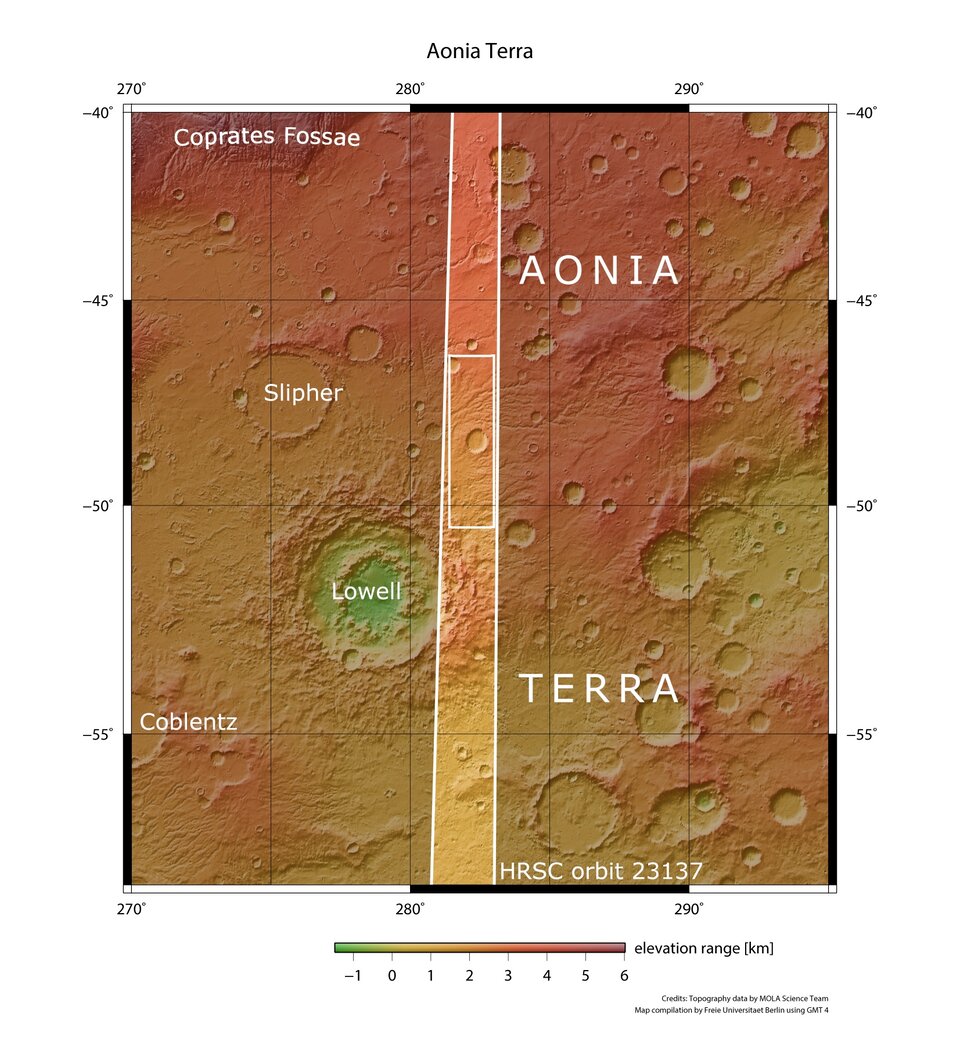Mars sleeps with one eye open
This scarred and colourful (by martian standards!) landscape shows part of Aonia Terra, an upland region in the southern highlands of Mars. The image was taken by ESA’s Mars Express on 25 April 2022.
The 30 km-wide unnamed crater at the centre of the image is nestled within a landscape of winding channels. Conjuring images of veins running through a human eyeball, these channels are likely to have carried liquid water across the surface of Mars around 3.5–4 billion years ago.
The channels appear to be partly filled with a dark material, and in some places, seem to actually be raised above the surrounding land. There are a variety of possible explanations for this. Perhaps erosion-resistant sediment settled at the bottom of the channels when water flowed through them. Or perhaps the channels were filled in with lava later on in Mars’ history.
A cacophony of colours

This Mars Express image reveals many different colours in the surface around the crater, suggesting that this region of Mars is made up of a variety of materials. South of the crater (on the left of the true-colour image above), the surface is a warm red, melting into a darker brownish-grey closer to the crater. In this region, many buttes are visible – these flat-topped towers of rock are created when land is gradually worn away by water, wind or ice.

Inside the crater, a dark dune field rests on a lighter surface. Upon closer inspection, it becomes apparent that the crater is filled with more buttes and cone-shaped hills. These are evidence that many different materials accumulated inside the crater.
To the north of the crater (right of the wide view image), the surface is lighter and smoother. The rims of the main crater and the channels appear less defined. To the far right of the image, the surface becomes even smoother.
Aonia Terra

Aonia Terra is known for its impressive craters. Close to the crater shown in this image is the 200 km-wide Lowell crater. Lowell is thought to have been formed almost four billion years ago, during the Solar System’s ‘Late Heavy Bombardment’ period, when a large number of asteroids crashed into the rocky planets.
Aonia Terra is named after a feature called Aonia, a dark patch on the surface of Mars that can be seen from Earth, even with rudimentary telescopes. Aonia was also a region in ancient Greece, a location sacred to the Muses, the goddesses of literature, science and the arts.
Exploring Mars
Mars Express has been orbiting the Red Planet since 2003, imaging Mars’ surface, mapping its minerals, identifying the composition and circulation of its tenuous atmosphere, probing beneath its crust, and exploring how various phenomena interact in the martian environment.
The mission’s High Resolution Stereo Camera (HRSC), responsible for these new images, has revealed much about Mars’ diverse surface features, with recent images showing everything from wind-sculpted ridges and grooves to volcanoes, impact craters, tectonic faults, river channels and ancient lava pools.















 Germany
Germany
 Austria
Austria
 Belgium
Belgium
 Denmark
Denmark
 Spain
Spain
 Estonia
Estonia
 Finland
Finland
 France
France
 Greece
Greece
 Hungary
Hungary
 Ireland
Ireland
 Italy
Italy
 Luxembourg
Luxembourg
 Norway
Norway
 The Netherlands
The Netherlands
 Poland
Poland
 Portugal
Portugal
 Czechia
Czechia
 Romania
Romania
 United Kingdom
United Kingdom
 Slovenia
Slovenia
 Sweden
Sweden
 Switzerland
Switzerland




























